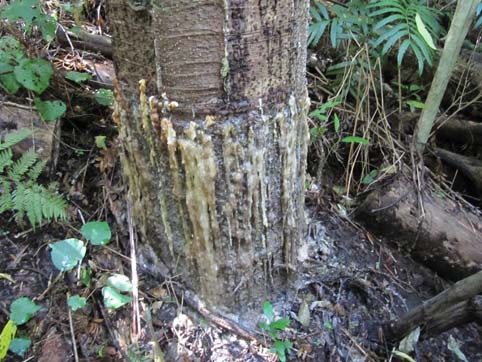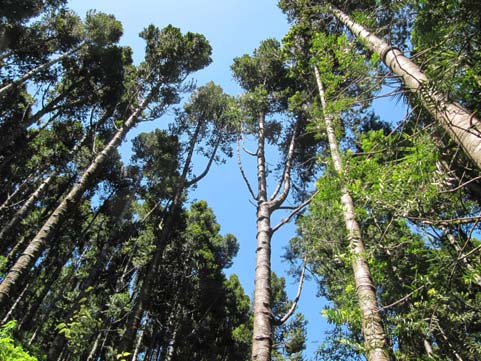PESTS AND DISEASES OF FORESTRY IN NEW ZEALAND
Resinosis on Agathis australis (Kauri)
Scion is the leading provider of forest-related knowledge in New Zealand
Formerly known as the Forest Research Institute, Scion has been a leader in research relating to forest health for over 50 years. The Rotorua-based Crown Research Institute continues to provide science that will protect all forests from damage caused by insect pests, pathogens and weeds. The information presented below arises from these research activities.
From Forest Health News 201, December 2009.

In October 2009 Scion silvicultularist Greg Steward noted severe resin bleed around the base of a number of kauri (Agathis australis) trees in Brooklands Park, which is part of the larger Pukekura Park, in New Plymouth. A similar situation was observed in the nearby Fred Cowling Reserve at Barrett Domain although there were fewer affected trees and resinosis was less extensive. Greg alerted New Plymouth City Council parks staff who were immediately concerned that the Phytophthora associated with dying kauri in Northland and Auckland might be responsible (see FH News 199 October 2009). This resulted in an article in Taranaki Daily News on 20 October 2009 and an invitation for a Scion forest pathologist familiar with Phytophthora to visit the site and investigate the cause of the resinosis on the trees.
The kauri at both sites were planted in the 1930s and permanent sample plots were established in the 1980s. These plots have been routinely assessed and during the 2009 evaluation resinosis was observed. The Brooklands stand was thinned in 2002 and Barrett Domain was thinned in 2004. In both stands considerable volumes of stem and foliage were left on the forest floor following thinning.
A follow-up visit, to inspect the trees more closely and to collect samples for analysis, was undertaken in early November 2009 by Greg Steward and Scion forest pathologist Margaret Dick. Six trees with a ring of fresh resin bleed around the butt up to a height of approximately 1m in Brooklands, and 5 trees with resin bleeding around the root collar at Barretts Domain were found.
Bark and wood samples were collected from the stems of five trees. When the bark was removed from the resinous part of the stems the characteristic mycelium of an Armillaria species was clearly visible. Crowns of trees at both locations were healthy with full foliage and no signs of dieback.

In the laboratory small pieces of wood and bark were placed onto a selection of fungal growth media, one selective for Phytophthora spp., one selective for basidiomycete fungi such as Armillaria and a general fungal growth medium.
Soil samples were collected from beneath five affected trees at Brooklands and a composite sample was collected from Barrett Domain. These soil samples were separately bioassayed for the presence of Phytophthora spp.
No species of Phytophthora were isolated from any of the bark, wood or soil samples. There was therefore no evidence that the resinosis was caused by Phytophthora taxon Agathis, or that this organism was present at either of the two sites.
An Armillaria sp. was readily recovered from the affected wood using the other isolation media. No other plant pathogens were isolated. Specific identification of Armillaria species is a time consuming process and is still underway.
Armillaria was the sole plant pathogen recovered from the samples and in this instance is the likely cause of the resinosis. Four species of Armillaria are known to occur naturally as decay fungi in indigenous forests in New Zealand, two of which, Armillaria novae-zelandiae and A. limonea, are responsible for armillaria root disease in a wide variety of exotic trees and shrubs. There are occasional records of indigenous plants becoming infected by these native Armillaria spp. when circumstances promote fungal development and perhaps also mitigate against tree defence mechanisms. In New Plymouth it is possible that the thinning undertaken in both stands provided the tree stumps and the woody debris that became the food source for rapid growth of the fungus and the attack of a usually resistant host.
Whether the affected trees, which have no signs of dieback in the canopy, can withstand the basal stem attack will remain to be seen. The pattern of stem resin bleeding in response to Armillaria attack tends to be a little different to that most commonly observed in trees with Phytophthora taxon Agathis infection. However all findings of basal resin bleeding of kauri need to be checked by a plant pathologist so that an accurate diagnosis can be made.
Margaret Dick
This information is intended for general interest only. It is not intended to be a substitute for specific specialist advice on any matter and should not be relied on for that purpose. Scion will not be liable for any direct, indirect, incidental, special, consequential or exemplary damages, loss of profits, or any other intangible losses that result from using the information provided on this site.
(Scion is the trading name of the New Zealand Forest Research Institute Limited.)

 Farm Forestry New Zealand
Farm Forestry New Zealand

